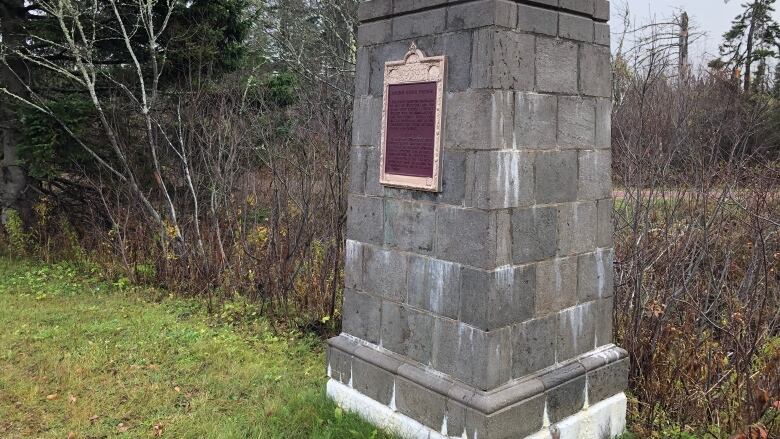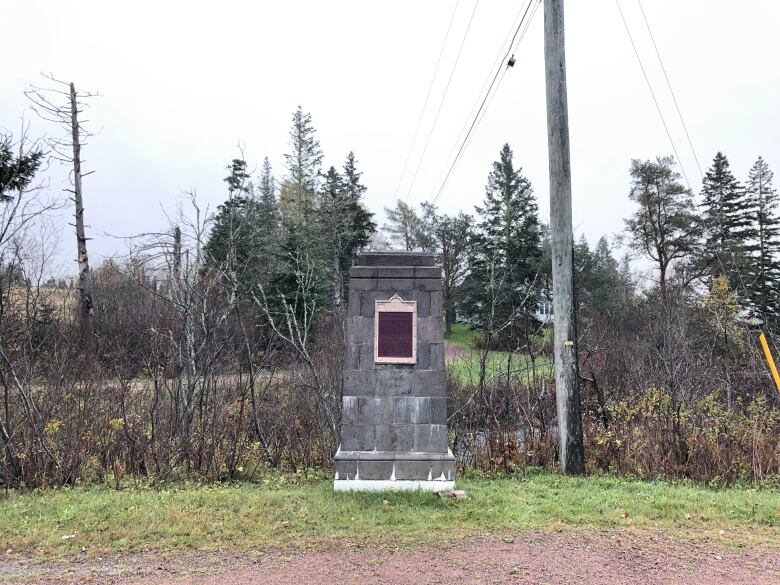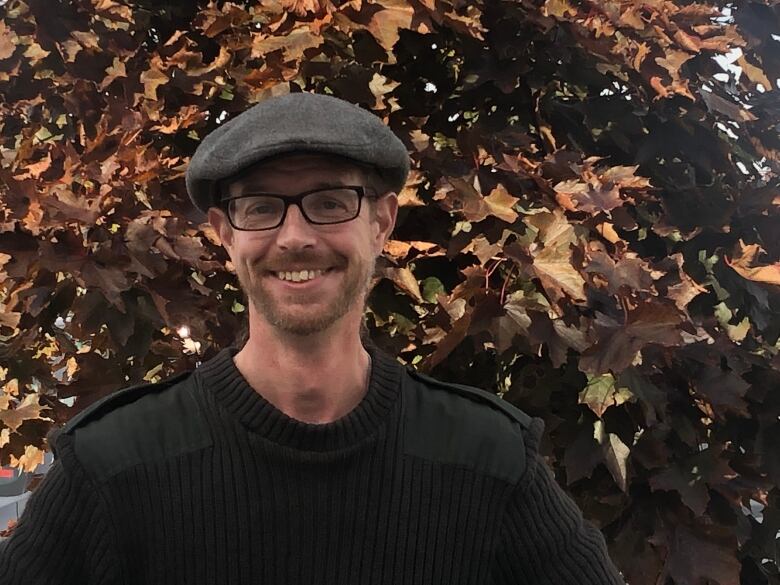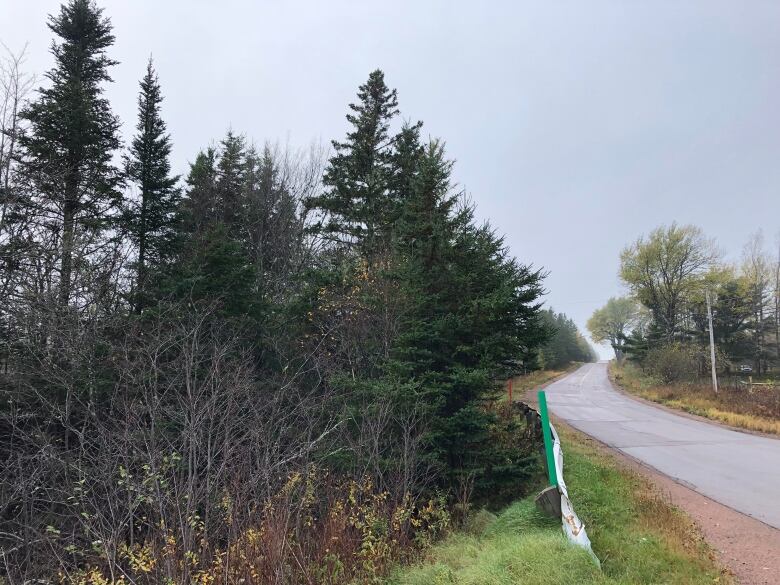Frosty Hollow monument marks ancient Mi'kmaw portage route
Quiet country road monument a reminder to slow down and appreciate those who travelled before us

A stone markeron a country road between Dorchester and Sackvilleis a reminder, James Upham says, to "slow down and actually take a couple of minutes to pay attention to what's around us."
The Moncton historian and educator explains that if you look closely at the plaque on this national monument unveiled in1952, you will see that this stretch of Route 106 is worthy of recognition.
It is thesite of an early Mi'kmawportage routeconnecting two riversthrough a place nowcalled Frosty Hollow.
"If you were going from Beaubassin or Sackville and you were heading over to Dorchester, this is probably the spot where you pick up the canoe, shoulder it, and start walking," Upham said

The plaque reads: "This route connected Beaubassin by way of Westcock and the valley now known as Frosty Hollow with the Memramcook and Petitcodiac rivers and was an important link in the communications system between Acadia and Quebec."
Designated heritage site
Upham said that very short dedication is to let us know that this was a route that mattered.
"People have walked through the exact spot that we're in right now, knowing exactly how to use the river systems and trails of this entire region to literally paddle and walk from this spotto Quebec City."

Tom Johnson,who workswith the non-profitMi'gmawe'l Tplu'taqn Inc.representing nine New BrunswickMi'kmawcommunities,saysportage routes often followed the same paths worn by animals.
"The portage routes were used to travel all over the province and into central Turtle Island, which is now Quebec," he said, pointing out thatroutes around the Petitcodiac River would have been especially well used.
"Anybody travelling from Nova Scotia would be funnelled through the Chignecto Isthmus and then, they hit the Petitcodiac River."
Johnson, whose family is from Neqotkukin northwestern New Brunswick,has created an interactive map that includes Indigenous place names and historic details.

He describes the Petitcodiac River as a "great time and labour saver" thanks to the tidal bore, which would propel canoes 30 kilometres upstream twice each day towardthe next portage route near Petitcodiac.
"Mi'kmaq and Wolastoqey have been on these lands since time immemorial, since the times of the last Ice Age," Johnson said.
"Hunting, travelling from one area to another, and just for socializing too. These communities were small, and it was not uncommon for men to travel to other communities to seek brides."
In New Brunswick there are two other monumentscommemorating the network of waterways and portage trails, including one northeast of Petitcodiacalso on Route 106, where a portage route linked the Petitcodiac River and the Canaan River.
The other isalong Route 970 inBaie Verte,where there was a trail connecting the Missaguash River and Baie Verte.
Portage routes restored
Tim Humesof Miramichi is so fascinated by the history of these ancient portage routes, that he is co-leadinga project by Canoe Kayak New Brunswick to rediscover and restore six ancient portage trails in New Brunswick."In a sense it's the reverse of today's travelling," he said. "The rivers or the waterways were the former highways and the connecting land masses were the bridges."

Robert Doyle is researching and writing a book about the ancient portage trails of New Brunswick. Heshared with CBC News what he has learned about the 8-kilometre trail that ran through Frosty Hollow.
In his yet-to-be-published book, Doyle includes a statement from 1753 by two French missionaries that details the route through Frosty Hollow and explains how it was used to maintain communicationduring the struggle between France and England for control of eastern North America.
Doyle writes, "This very important communication route the French were using betweenwhat is now Qubec City and FortBeausjour was mostly by way of riversand the portage trails that connected these rivers."
Humes calls it "pretty amazing" that people navigated nearly 100 trailsacross the province based solely on information that was passed down orally.

Those early Europeans, Johnson said, would have depended on Indigenous guides to get around. He said much of theknowledge waspassed on orally, but it was also built into the very descriptive Indigenous names.
He cited the Petitcodiac, Memramcook, Shediac, Scoudouc and Richibucto rivers as examples of names that are rooted in the Mi'kmaw language, and said that's whymost rivers in New Brunswickretained their Mi'kmaw and Wolastoqey names.
A reminder of our place in history
Upham knows most people don't stop to read roadside monuments, but he argues they should.
"This is a place where a lot of really neat stuff has happened historically over a lot of centuries and probably even more like millennia," he said.
"We're literally at an intersection here between different forms of transportation and different ways of looking at the world and historic eras."
- 'Engineering masterpiece' to shuttle ships between N.B. and N.S. lost to time
- Gravestone in rural New Brunswick reveals mysterious deaths in 1869
Thespot in Frosty Hollow was designated a federal heritage site in 1943, and the monument unveiled in 1952,but Upham said it was in the 1920s and '30s that people started taking stock and thinking about what deserved recognition.
"They had just fought World War I. They've been through the Spanish flu,this horrible pandemic. They're in sort of a similar situation to what we are in, where there's been a lot of change.
"And one of the incredible things they do at that point is they build these actual monuments. They say, 'OK, we're going to look around and try to figure out how did we get here? What led us to this point?'"

Even though the economy was in "a horrible state," Upham saidpeople in the 1930s and '40s kept building monuments like the one in Frosty Hollow.
"These people were trying to tell us, slow down and look at them and pay attention," he said. "You can smell the same smells that they would have smelled, you can hear the same sounds they would have heard."
Monuments like this, Upham argues, are a reminder of our place in history, and provide a "fascinating" perspective on the world we live in now.

"We're standing next to a creek. Somebody was the first human being to walk up that creek trying to figure out where it went. Somebody a little later on was the first person to think, 'OK, I'm going to try it with a canoe now.' That took guts.
"If we take our heads out of our phones for a minute, take a step out of our door and look around, we are literally surrounded by thousands of fascinating things all the time that are waiting for us just to look."
with files from Khalil Akhtar, Oscar Baker III, Shane Fowler












_(720p).jpg)


 OFFICIAL HD MUSIC VIDEO.jpg)
.jpg)



























































































